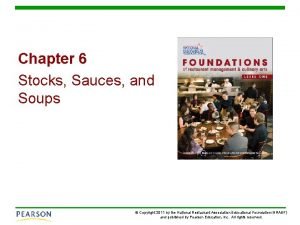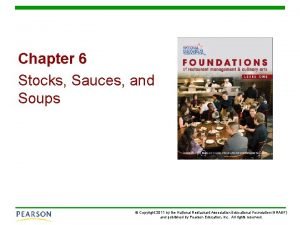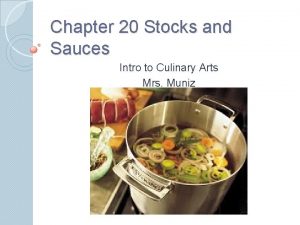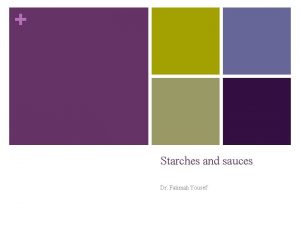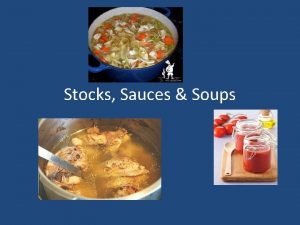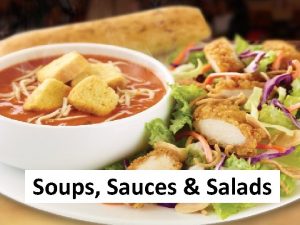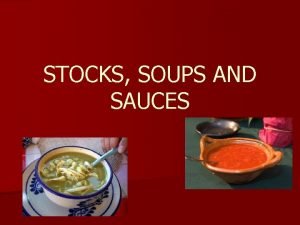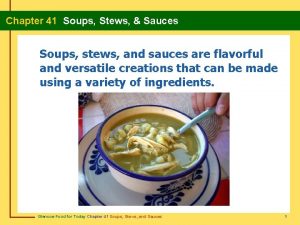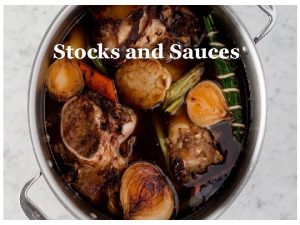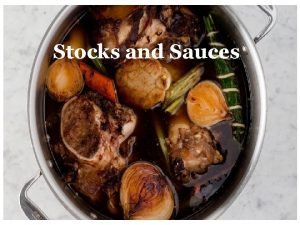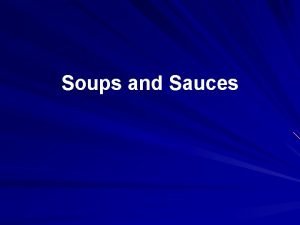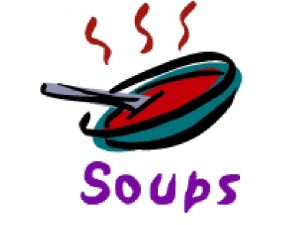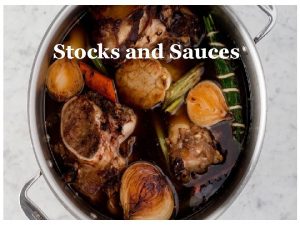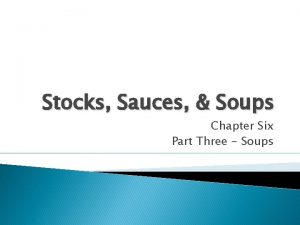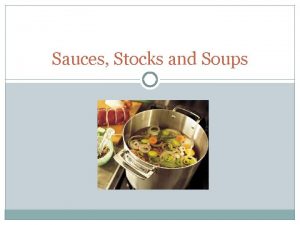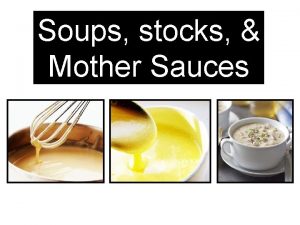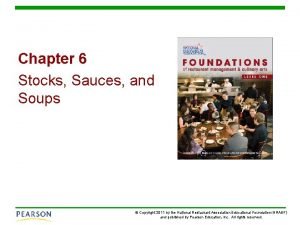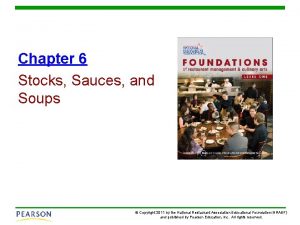Chapter 6 Stocks Sauces and Soups Copyright 2011














- Slides: 14

Chapter 6 Stocks, Sauces, and Soups © Copyright 2011 by the National Restaurant Association Educational Foundation (NRAEF) and published by Pearson Education, Inc. All rights reserved.

The Essential Parts of Stock § There are _________parts to all stocks: § § A major ______ ingredient A ______, most often water ________________ § ______ is a French word that refers to the mixture of coarsely chopped onions, carrots, and celery that provide a flavor base for stock. § _______, such as bouquet garni and sachet d’épices, are the herbs, spices, and flavorings that create a savory smell. 6. 1 Chapter 6 | Stocks, Sauces, and Soups 2

Types of Stocks A stock is a ___________made by gently simmering bones and/or vegetables. § Stocks are often called the chef’s “_____ blocks. ” They form the base for many soups and sauces. § There are many types of stock: § ______ stock, _______ stock, fumet, _______, glace, remouillage, bouillon, jus, and vegetable stock § To use _______ for stock, you must first cut them to the right size and then prepare them by ______, browning, or _____. 6. 1 Chapter 6 | Stocks, Sauces, and Soups 3

Preparing Stocks § Blanching the bones rids them of some of the impurities that can cause ______ in a stock. § To brown bones, roast them in a hot (400°F) oven for about an hour, until they are _____________. § ______ causes bone and mirepoix to release flavor more quickly when liquid is added. § Flavor, _____, body, and clarity determine the quality of stock. A stock should be ______, but not so strong that it overpowers the other ingredients in the finished dish. § To make stock, the ratio of liquid to flavoring ingredients is ______. § Follow proper food safety practices when cooling stock to minimize the time the stock spends in the ________. 6. 1 Chapter 6 | Stocks, Sauces, and Soups 4

Degreasing Stock ________ is the process of removing fat that has cooled and hardened from the surface of the stock. § Degreasing gives the stock a _____ and purer color. § Degreasing also removes some of the ______, making the stock more healthful. § Degrease stock by _____, scraping, or lifting hard fat. 6. 1 Chapter 6 | Stocks, Sauces, and Soups 5

Section 6. 1 Summary § Stocks contain four essential parts: a major flavoring ingredient, liquid, _____, and ______. § There are many types of stock, including white stock, brown stock, _____, court bouillon, glace, ______, bouillon, jus, and vegetable stock. § When using bones for stock, you must cut them to the right size and prepare them by _____, browning, or sweating. § Degreasing is the process of removing fat that has cooled and hardened from the surface of the stock by _____ or scraping it away before the stock is _______. § To cool stock, follow good food _____ practices and limit the time the stock spends in the _______ (TDZ). 6. 1 Chapter 6 | Stocks, Sauces, and Soups 6

Grand Sauces A _______ is a liquid or semisolid product that is used in preparing other foods. § Sauces add flavor, moisture, and ______to another dish. § A _____ is a cook who specializes in making sauces. § There are five classical grand sauces that are the basis for most other sauces: § _______: Made from milk and white roux § _______: Made from veal, chicken, or fish stock and a white or blond roux § ____ __ ______: Made from brown stock and brown roux § _________: Made from a stock and tomatoes § ________: This is an emulsion made from eggs, butter, and lemon. 6. 2 Chapter 6 | Stocks, Sauces, and Soups 7

Basic Ingredients in Sauces need a liquid component. A key ingredient in sauce is the ______, which adds richness and body. § ______ is a thickener made of equal parts cooked flour and a fat, such as clarified butter, oil, or shortening. § __________ is a thickener made of equal parts flour and soft, whole butter. § A ______, cornstarch mixed with a cold liquid, can be used instead of roux. § A ______ is a mixture of egg yolks and heavy cream, often used to finish some sauces. 6. 2 Chapter 6 | Stocks, Sauces, and Soups 8

Preparing Different Kinds of Sauces § __________is a mixture of raw butter and various flavoring ingredients, such as herbs, nuts, citrus zest, shallots, ginger, and vegetables. § ______ is a thick puréed sauce. § ______ is a cold mixture of fresh herbs, spices, fruits, and/ or vegetables. It can be used as a sauce for meat, poultry, fish, or shellfish. § Jus-lié is a sauce made from the ____ from cooked meat and _______ stock. § The easiest way to strain sauce is the _____ method. In this method, place a clean cheesecloth over a bowl, and pour the sauce through the cheesecloth into the bowl. 6. 2 Chapter 6 | Stocks, Sauces, and Soups 9

Section 6. 2 Summary § There are ____ classical grand sauces that are the basis for most other sauces. These are béchamel, _____, brown or espagnole sauce, ____ sauce, and hollandaise. § Thickeners, such as roux, __________, slurry, and liaison, add _______ and body to sauces. § There are other sauces that are not classified as grand sauces or as derivatives of grand sauces. These include compound butters, ______, and _____. In addition, some sauces are made with the natural juices from meat, such as jus-lié or au jus. § You should match sauces to the type of food you are serving. Consider factors such as the main ingredient of the dish and how the flavors will _______ each other. 6. 2 Chapter 6 | Stocks, Sauces, and Soups 10

Basic Kinds of Soup There are _____ basic kinds of soup—_____soups and _____ soups. § __________include flavored stocks, broths, and consommés. § Thick soups include cream soups and _______ soups, such as bisques, ______, cream of tomato, lentil, and split pea soup. § There are many variations of these basic soups: § § 6. 3 __________ soups ________ regional soups Chapter 6 | Stocks, Sauces, and Soups 11

Preparing Soups § Most soups are cooked at a ________and stirred occasionally. § Finishing techniques are important when preparing soup for service. Soups should also be _____ just before service. § Stock or broth is the basic ingredient in _____ soups. Broth is made from a combination of water; vegetables; ______, fish, chicken, or ____; mirepoix; and bouquet garni. § One type of clear soup is _____. This is a rich, flavorful broth or stock that has been ______. 6. 3 Chapter 6 | Stocks, Sauces, and Soups 12

Preparing Soups (cont. ) § There are two kinds of thick soup— _______ soups and ______ soups. § The main difference between a purée and cream soup is that cream soups are usually thickened with an added starch, such as ______: § Purée soups are thickened by the starch found in the puréed ____________, such as potatoes. § ______ is a cream soup usually made from puréed shellfish shells, such as lobster, shrimp, or crab. § Chowders are hearty, ______ soups made in much the same way as _______soups. 6. 3 Chapter 6 | Stocks, Sauces, and Soups 13

Section 6. 3 Summary § There are two basic kinds of soup—_____ and ______. Clear soups include flavored stocks, ____, and consommés. Thick soups include cream and purée soups. § Stock or broth is the basic ingredient in clear soups. _____ is a rich, flavorful broth or stock that has been clarified. § Cream soups are made with a thickener, such as _____. The main flavor in cream soups should be the major ingredient. § The main difference between a _____ and cream soup is that cream soups are usually thickened with an added _____. § _____ soups are thickened by the starch found in the puréed main ingredient (such as potatoes). § There are many kinds of soup, including _____ soups, and _______-based soups. 6. 3 Chapter 6 | Stocks, Sauces, and Soups 14
 Chapter 6 stocks sauces and soups
Chapter 6 stocks sauces and soups Chapter 6 stocks sauces and soups
Chapter 6 stocks sauces and soups Chapter 6 stocks sauces and soups
Chapter 6 stocks sauces and soups Bechamel sauce
Bechamel sauce Chapter 6 stocks sauces and soups
Chapter 6 stocks sauces and soups Store and reconstitute stocks sauces and soups
Store and reconstitute stocks sauces and soups A mix of coarsely chopped vegetables and herbs
A mix of coarsely chopped vegetables and herbs Five major sauces
Five major sauces What are the essential parts of stock.
What are the essential parts of stock. What do soups stews and sauces have in common
What do soups stews and sauces have in common Different stocks and sauces
Different stocks and sauces Stocks and sauces
Stocks and sauces Classification of sauce
Classification of sauce Classification of soup
Classification of soup Chapter 11 stocks
Chapter 11 stocks

